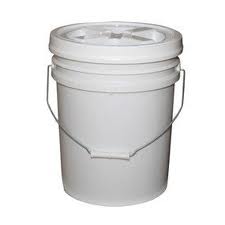Storing Survival Food in Food Grade Five-Gallon Buckets and Mylar Bags
When it comes to storing survival food there are a lot of things to take into consideration, and having space in the fridge isn’t one of them. So how and in what can you store your food?
The Value of a Good Bucket

One of the best things you can do in terms of storing survival food is to purchase food grade buckets and Mylar bags for linings. Oxygen destroys food over time so keeping your food inside Mylar bags, which acts as food barriers, helps your food to last much longer.
You can purchase air and water tight lids for food grade storage buckets so if you’re going to spend the money on buckets, spend money making sure your food lasts. The last thing you want to do is to open a bucket in front of five hungry people only to find it has all spoiled.
Gamma sealed bucket lids are perfect for this and are reusable. Without contacting the manufacturer it can be hard to tell if a bucket is safe for food storage short of it saying FDA on the outside. Sometimes you can get food safe buckets free from restaurants and grocery stores. Just make sure the buckets weren’t used for storing other things like paint before you got ahold of it.
Things to Keep in Mind
When you’re thinking about storing survival food you want to make sure all your hard earned money doesn’t go to waste; or to the bugs and vermin. Warm temperatures will cause your stored food to lose its nutritional value and high humidity and water will spoil it very fast.
Of course, you have to keep it away from vermin as well. You don’t want to have to eat the mice to get to the food you had been storing. Also, if you do have a real rodent problem, you might consider storing dry goods in metal or glass containers, as mice and rats have been known to chew through plastic containers.
You also have to store your food in the right kind of containers. Some materials containers are made from react with chemicals in food and ruin your supply. It’s best to use air-tight containers as oxygen is a killer. Some plastics leach toxins into food over time. You certainly don’t want to store your food in a plastic bucket that used to be used for laundry detergent either. It’s best to keep your safe food containers in a cool dry environment.
Where Not to Store Survival Food
Storing survival food is best done in places that are kept cool and dry. That makes most people immediately think of their basement; if they have a house. The problem here is that most basements have a dual purpose of storing things and housing your homes heating and cooling systems; making the basement too warm or moist for storing foods in the long term.
Food cellaring, as it’s called is best done some other place, other than the basement. It’s better to just dig a separate space outside if you have the yard and the means to do so.
For some foods, the best way to store them is where they came from; the ground. Some root vegetables like potatoes, carrots, turnips, and parsnips can stay in the ground even through the winter months. When the ground begins to freeze cover it with mulch like dry leaves and straw to protect your food from severe freezes.
Hold on to What You Have
If you’re going to go through all the expense and time buying and preparing the right foods for long term storing survival food, make sure what you have doesn’t go to waste. Probably the biggest killer of good foods is oxygen. As much as possible try to keep your foods in a cool, dry, oxygen free environment. You can even buy packets that remove oxygen from your food.
Food grade buckets in conjunction with Mylar bags are a great way to store your food. Be sure to buy re-sealable lids to go with your buckets. Also you
can buy food vacuum sealer bags, which means you can prepare all kinds of foods
and vacuum the oxygen from them yourself.
Or you can buy whole year supply kits from distributers direct (plus the containers) – just be sure you buy a mix of varieties as a whole year of just one type of foodstuff, will get pretty mundane.
Put as much effort into storing your food as you do getting it and you will probably be fine.
Return from Storing Survival Food to Survival Food





New! Comments
Have your say about what you just read! Leave me a comment in the box below.